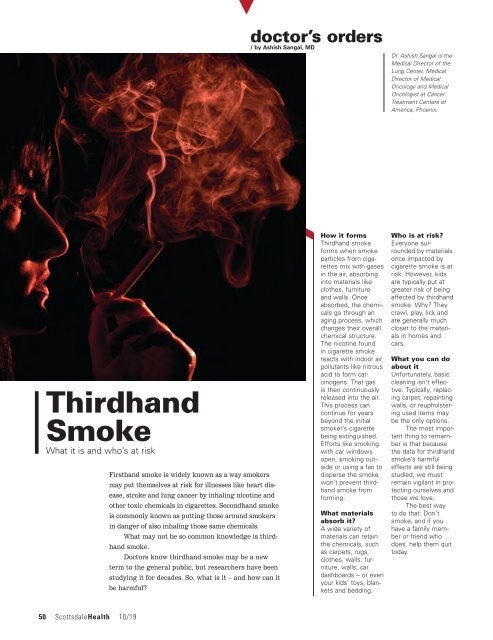Scottsdale Health October 2019
You also want an ePaper? Increase the reach of your titles
YUMPU automatically turns print PDFs into web optimized ePapers that Google loves.
doctor’s orders<br />
/ by Ashish Sangal, MD<br />
Dr. Ashish Sangal is the<br />
Medical Director of the<br />
Lung Center, Medical<br />
Director of Medical<br />
Oncology and Medical<br />
Oncologist at Cancer<br />
Treatment Centers of<br />
America, Phoenix.<br />
Thirdhand<br />
Smoke<br />
What it is and who’s at risk<br />
Firsthand smoke is widely known as a way smokers<br />
may put themselves at risk for illnesses like heart disease,<br />
stroke and lung cancer by inhaling nicotine and<br />
other toxic chemicals in cigarettes. Secondhand smoke<br />
is commonly known as putting those around smokers<br />
in danger of also inhaling those same chemicals.<br />
What may not be so common knowledge is thirdhand<br />
smoke.<br />
Doctors know thirdhand smoke may be a new<br />
term to the general public, but researchers have been<br />
studying it for decades. So, what is it – and how can it<br />
be harmful?<br />
How it forms<br />
Thirdhand smoke<br />
forms when smoke<br />
particles from cigarettes<br />
mix with gases<br />
in the air, absorbing<br />
into materials like<br />
clothes, furniture<br />
and walls. Once<br />
absorbed, the chemicals<br />
go through an<br />
aging process, which<br />
changes their overall<br />
chemical structure.<br />
The nicotine found<br />
in cigarette smoke<br />
reacts with indoor air<br />
pollutants like nitrous<br />
acid to form carcinogens.<br />
That gas<br />
is then continuously<br />
released into the air.<br />
This process can<br />
continue for years<br />
beyond the initial<br />
smoker’s cigarette<br />
being extinguished.<br />
Efforts like smoking<br />
with car windows<br />
open, smoking outside<br />
or using a fan to<br />
disperse the smoke<br />
won’t prevent thirdhand<br />
smoke from<br />
forming.<br />
What materials<br />
absorb it?<br />
A wide variety of<br />
materials can retain<br />
the chemicals, such<br />
as carpets, rugs,<br />
clothes, walls, furniture,<br />
walls, car<br />
dashboards -- or even<br />
your kids’ toys, blankets<br />
and bedding.<br />
Who is at risk?<br />
Everyone surrounded<br />
by materials<br />
once impacted by<br />
cigarette smoke is at<br />
risk. However, kids<br />
are typically put at<br />
greater risk of being<br />
affected by thirdhand<br />
smoke. Why? They<br />
crawl, play, lick and<br />
are generally much<br />
closer to the materials<br />
in homes and<br />
cars.<br />
What you can do<br />
about it<br />
Unfortunately, basic<br />
cleaning isn’t effective.<br />
Typically, replacing<br />
carpet, repainting<br />
walls, or reupholstering<br />
used items may<br />
be the only options.<br />
The most important<br />
thing to remember<br />
is that because<br />
the data for thirdhand<br />
smoke’s harmful<br />
effects are still being<br />
studied, we must<br />
remain vigilant in protecting<br />
ourselves and<br />
those we love.<br />
The best way<br />
to do that: Don’t<br />
smoke, and if you<br />
have a family member<br />
or friend who<br />
does, help them quit<br />
today.<br />
50 <strong>Scottsdale</strong><strong>Health</strong> 10/19

















